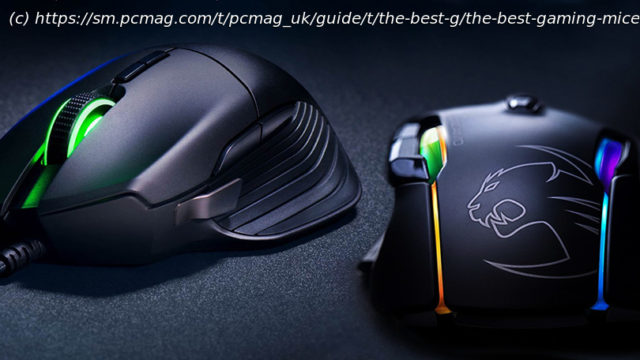The right mouse is the most critical weapon in your PC-gaming arsenal. Shape, weight, shortcuts, customization software: our buying guide has it all covered, and our top-rated picks will help you smoke the competition.
Targeting, slashing, hacking, attacking: The key actions you take in any PC game happen at the click of your mouse, so you can’t skimp on your weapon if you want to win. Today, though, the quality bar is high for all but the cheapest gaming mice, so you can afford to be picky. Nowadays, you should expect reliable connectivity, smooth and responsive tracking, and crisp click and scroll functions. Those are the table stakes—it takes much more to elevate a « good » gaming mouse to « great. » So, what makes the difference? Comfort and accuracy come more naturally to some models than others. An extra button in the right spot can speed up switching modes or weapons, saving you life-or-death fractions of a second. And the right supporting software can power simple or complex shortcuts that decide defeat or victory. Here’s what to look for in a right-fit gaming mouse. Sensors and Resolutions: Don’t Overthink ‘Em Nailing down a high-quality mouse sensor is tricky without getting hands-on time with a given mouse. The two key sensor types are « optical » and « laser » sensors, but you can’t apply absolutes when judging them. Your best bet is to try out a mouse in person, or to rely on formal reviews like ours, as well as online forums, for the skinny on how a mouse feels in specific play situations. Less-expensive mice tend to have optical sensors, which offer good tracking sensitivity and tend to map well on a variety of surfaces, including textured ones such as cloth. Laser sensors, on the other hand, map onto the same or more kinds of surfaces (including some smooth or glossy ones that may give optical sensors fits), but they can be more finicky about rough surface textures. That said, we wouldn’t let one kind or the other be the main reason you choose a mouse. Likewise, some vendors market branded versions of sensors that track, say, on glass or reflective surfaces. Don’t take them too seriously, as you can solve any challenging mousing surface with…a $2 mousepad. More important to look for is a suitable resolution range, measured in dots per inch (dpi), that allows for fine-grained and wide-sweep tracking. Just as crucial is a button or toggle that lets you adjust the setting easily on the fly—as opposed to only in software. Sometimes this button is on the top of the mouse for fast changes; on other mice, it’s on the underside for resolution changes outside the flow of the game. Which you want depends on your style of gameplay. (More about resolution switching in a moment.) The numbers you see in terms of mouse resolution, though, are less crucial. Mouse resolution is mostly a marketing numbers game. You would use extreme dpi settings in the five-figure range only if you have one or more very high-pixel-count displays, such as 4K monitors, to mouse across. So don’t put a whole lot of stock, say, in a 16,000dpi maximum setting versus a 14,000dpi one. Either will serve you well under most real-world circumstances. It’s (Still) a Wired World: Mouse Interfaces Gaming mice are either wired or wireless in design, but most of today’s high-end models still, surprisingly, use an old-school USB cable to connect to your computer. For a long time, competitive gamers strongly preferred wired gaming mice to wireless ones to eliminate perceived latency, as well as the possibility of a battery running down in the midst of a heated match. Many serious players still hold that bias, but Razer, Logitech, and others have released higher-end mice of late with low latency ratings that ought to satisfy all but the most extreme of gamers.






